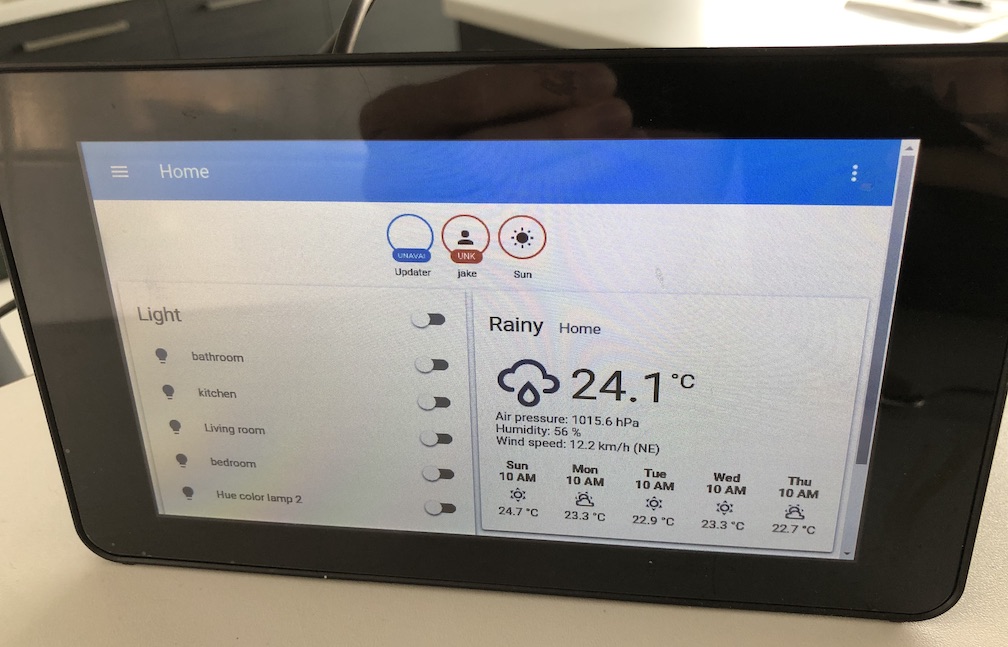For quite some time now I’ve been plotting to put a Raspberry Pi 3 model B to work as some kind of home automation/”smart” home thingy. After looking at a few options, I’ve more or less settled on Home Assistant- aka “Hass”. It seems to check all the boxes: open-source, optionally offline, just-works™, and not fugly. An official Android app was also recently announced.
Before getting started, install Raspbian or some other distribution of your choice.
Install
Installing Hass is easy. The top-level install instructions list three ways to do it:
- Hass.io; a full system image you would run as an appliance or in a VM
- Docker
- Manually in Python virtual environment
Here we’ll go through the manual route also referencing additional instructions for the Raspberry Pi. If you’re unfamiliar with Python/pip/venv, read “Installing packages using pip and virtual environments”.
If on Stretch need to manually install python >=3.7; apt only gives you 3.5:
# Build python 3.7
# `--enable-optimizations` uses tests that take a long time. First do a quick install and then do an optimized build later.
./configure --with-ensurepip=install
make -j2
make altinstall
sudo update-alternatives --install /usr/bin/python3 python3 /usr/bin/python3.5 50
sudo update-alternatives --install /usr/bin/python3 python3 /usr/local/bin/python3.7 40
# Switch to python3.7
sudo update-alternatives --set python3 /usr/local/bin/python3.7
# Or, for the TUI to manually select
#sudo update-alternatives --config python3
# Install pre-requisites
sudo apt-get install -y python3 python3-dev python3-venv python3-pip libffi-dev libssl-dev
# Create `homeassistant` user Hass will run as
sudo useradd -rm homeassistant -G dialout,gpio,i2c,audio
cd /srv
sudo mkdir homeassistant
sudo chown homeassistant:homeassistant homeassistant
# Switch to `homeassistant` user
sudo -u homeassistant -H -s
# Create python virtual environment and switch to it
cd /srv/homeassistant
python3 -m venv .
source bin/activate
# Install Home Assistant in venv and run once to complete setup
venv$ python3 -m pip install wheel
venv$ pip3 install homeassistant
venv$ hass
The first time it runs a bunch of additional packages will be installed. Once the following text appears installation has completed:
INFO (MainThread) [homeassistant.core] Timer:starting
Auto Start
Additional instructions are provided to make Hass start automatically at boot.
As super-user create /etc/systemd/system/home-assistant@YOUR_USER.service (where YOUR_USER is the name of the user you created above, in this case homeassistant):
[Unit]
Description=Home Assistant
After=network-online.target
[Service]
Type=simple
User=%i
ExecStart=/srv/homeassistant/bin/hass -c "/home/%i/.homeassistant"
# Restart on failure
Restart=on-failure
RestartSec=5s
[Install]
WantedBy=multi-user.target
For example:
sudo vim /etc/systemd/system/home-assistant@homeassistant.service
## Paste the above configuration then `:wq`
# Reload systemd and enable to start automatically at boot
sudo systemctl --system daemon-reload
sudo systemctl enable home-assistant@homeassistant
# Start it now
sudo systemctl start home-assistant@homeassistant
For help debugging Hass installs:
sudo systemctl status home-assistant@homeassistant
# Stop Home Assistant
sudo systemctl stop home-assistant@homeassistant
# Restart Home Assistant
sudo systemctl restart home-assistant@homeassistant
# View log output
sudo journalctl -f -u home-assistant@homeassistant
Dashboard
My Pi is tucked inside the official 7” Touch Display, and I’d like to have it launch the Hass GUI as a dashboard to serve as a control panel for my entire flat. The two main approaches are:
There’s a few more ideas in this forum thread.
Systemd
I first tried the solution from this post about starting a dashboard on a Raspberry Pi 4. It didn’t work for me, but I didn’t spend much time debugging it so I plan to come back to it.
As super-user create /etc/systemd/system/dashboard.service:
[Unit]
Description=Chromium Dashboard
Requires=graphical.target
After=graphical.target
[Service]
Environment=DISPLAY=:0.0
Environment=XAUTHORITY=/home/pi/.Xauthority
Type=simple
ExecStart=/home/pi/dashboard.sh
Restart=on-abort
User=pi
Group=pi
[Install]
WantedBy=graphical.target
Create ~/dashboard.sh:
#!/usr/bin/env bash
# Prevent putting screen to sleep
xset s noblank
xset s off
xset -dpms
# Hide mouse cursor
unclutter -idle 0.5 -root &
# Ignore "unclean" Chrome shutdowns
sed -i 's/"exited_cleanly":false/"exited_cleanly":true/' /home/pi/.config/chromium/Default/Preferences
sed -i 's/"exit_type":"Crashed"/"exit_type":"Normal"/' /home/pi/.config/chromium/Default/Preferences
# Open Home Assistant dashboard
/usr/bin/chromium-browser --noerrdialogs --disable-infobars --kiosk http://localhost:8123 &
# Make the script executable
chmod +x ~/dashboard.sh
# Install helper
sudo apt-get install unclutter
# Enable the service
sudo systemctl enable dashboard.service
# Optionally, view log output
sudo journalctl -f -u dashboard.service
Autostart
The solution that did work for me was following a sparkfun tutorial covers using autostart to launch a program at startup. Create ~/.config/autostart/dashboard.desktop:
[Desktop Entry]
Type=Application
Name=Dashboard
Exec=/home/pi/dashboard.sh
Here using the same dashboard.sh from above.
End Result
The default GUI is servicable:

During Hass initial setup it automatically detected the Philips Hue “smart lighting” in my home. You can turn lights on and off, adjust the brightness, etc. And by supplying my location there’s a weather widget with the local weather and forecast.
This serves as a good starting point. Next I’ll be looking at doing some actual automation and getting some other features working.
Common Problems
If you don’t install ffi, pip install homeassistant will fail with:
c/_cffi_backend.c:15:10: fatal error: ffi.h: No such file or directory
#include <ffi.h>
^~~~~~~
There are issues installing hass without venv:
2019-10-04 03:16:59 INFO (MainThread) [homeassistant.setup] Setting up recorder
Exception in thread Recorder:
Traceback (most recent call last):
File "/usr/lib/python3.6/threading.py", line 916, in _bootstrap_inner
self.run()
File "/usr/local/lib/python3.6/dist-packages/homeassistant/components/recorder/__init__.py", line 211, in run
from .models import States, Events
File "/usr/local/lib/python3.6/dist-packages/homeassistant/components/recorder/models.py", line 6, in <module>
from sqlalchemy import (
ModuleNotFoundError: No module named 'sqlalchemy'
2019-10-04 03:17:09 WARNING (MainThread) [homeassistant.setup] Setup of recorder is taking over 10 seconds.
If not using venv and python3 -m pip install without sudo or --user:
ERROR: Could not install packages due to an EnvironmentError: [Errno 13] Permission denied: '/usr/local/lib/python3.6/dist-packages/_cffi_backend.cpython-36m-aarch64-linux-gnu.so'
Consider using the `--user` option or check the permissions.
If you ssh in without -X, hass --open-ui gets stuck without UI:
2019-10-04 22:02:40 INFO (MainThread) [homeassistant.core] Timer:starting